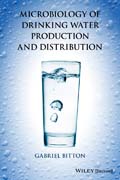
INDICE: Table of Contents Outline Major Pathogens and Parasites of Concern in Drinking Water Fate of Pathogens and Parasites in Drinking Water Treatment Plants Disinfection of Drinking Water Drinking Water Distribution Systems: Biofilm Microbiology Biological Problems Associated with Water Treatment and Distribution Biostability of Drinking Water Bioterrorism and Drinking Water Safety Water Treatment Technologies for Developing Countries Bottled Water Microbiology Brief description of chapter’s topics Chapter 1 discusses the major transmission routes of pathogens and parasites, describes the major bacterial and viral pathogens and protozoan parasites that may contaminate drinking water and ends with a brief discussion of microbial risk assessment. Chapter 2 deals with the microbiology of the treatment processes involved in water treatment plants. Advances in drinking water research followed by the establishment of multiple barriers against microbial pathogens and parasites have significantly increased the safety of the water we drink daily, particularly in industrialized nations. This multiple–barrier system includes source water protection, reliable water treatment (pretreatment, coagulation, flocculation, sedimentation, filtration, disinfection), and protection of the water distribution network. Other processes discussed in this chapter are water softening, membrane filtration, activated carbon treatment and the potential use of nanotechnology for water purification. Chapter 3 discusses the disinfection step that is an essential and final barrier against human exposure to disease?causing pathogenic microorganisms, including viruses, bacteria and protozoan parasites. Disinfection of drinking water is probably the most significant preventive measure in human history. Following the discovery of the “germ theory” by Louis Pasteur and Robert Koch in the 1880s, chlorination was initiated at the beginning of the 20th century to provide an additional safeguard against pathogenic microorganisms. The following disinfectants are discussed: chlorine, chlorine dioxide, ozone, ultraviolet radiation and photocatalysts. Other means for physical removal/inactivation of pathogens and parasites include membrane filtration, ultrasound, ultrahigh hydrostatic pressure and nanomaterials. Household water treatment via the use of point–of–use (POU) devices is also included in this chapter. Chapter 4 The water distribution system (WDS), an essential component of drinking water treatment, is the “workhorse” that carries drinking water from the plant to the customer. The daily production in the U.S is estimated 34 billion gallons of drinking water that flows through 1.8 million miles of distribution pipes. It is estimated that approximately 2/3 of the pipes are made of plastic, mostly polyvinylchloride (PVC). Many waterborne outbreaks are attributed to the degradation of water quality in water distribution systems through cross–connections, main breaks, back siphonage or negative pressure events. The main topic covered in this chapter is biofilm microbiology with emphasis on biofilm formation and the factors involved in its development in water distribution pipes. The fate of pathogens (e.g., non tubercular mycobacteria, Legionella , protozoan parasites, enteric viruses and opportunistic pathogens in general) in WDS is also covered. Chapter 5 covers the biological problems that can affect drinking water quality in water distribution systems. These problems include taste and odor problems in general, algae and cyanotoxins produced by cyanobacteria, fungi, actinomycetes, protozoa with emphasis on free living amoebas, invertebrates, endotoxins, iron and manganese bacteria, and the occurrence of nitrifying bacteria. Chapter 6 deals with the biostability of drinking water. It discusses the processes involved in the biological treatment of drinking water. The goal of biological treatment is to remove trace organics and nutrient levels in order to obtain biologically stable water which limits the growth of microorganisms in distribution pipes and reservoirs. This chapter also covers the various methods used to assess biostability of drinking water. Chapter 7 deals with the biosafety of drinking water and describes the characteristics of major bioterrorism agents (BT) which might be used to deliberately contaminate drinking water. It also describes the major bacterial (e.g., Clostridium botulinum toxin), cyanobacterial (e.g., microcystins), fungal (e.g., aflatoxins, patulin, fumonisin) and algal biotoxins (e.g., saxitoxin) and their potential for weaponization and threats to drinking water supplies. This chapter also covers the safeguards put in place to address the accidental or deliberate contamination of drinking water, the early warning systems to assess the contamination of source waters as well as treated and distributed water, and the disinfection of BT–contaminated water. Chapter 8 deals with the drinking water situation in developing countries. An estimated 1.1 billion of the world’s population does not have access to safe clean water, and approximately 2.6 billion people lack improved sanitation. As a result, approximately 2.2. million people die each year from waterborne diseases. The World Health Organization estimates that endemic diarrhea accounts for 17% of all deaths among children less than 5 years of age. Thus, several technologies and interventions have been proposed to improve drinking water quality in developing countries. These point–of–use or community–scale water treatment technologies must be simple, low–cost, low–maintenance and should require locally available materials. This chapter covers the major treatment technologies for improving the quality of drinking water in developing countries. Chapter 9 addresses bottled water microbiology. Due to good marketing, sales of bottled water have exploded around the world. However, we now know that this resource harbors indigenous microorganisms but can become contaminated with microbial pathogens and parasites as well as potentially harmful chemicals at the source or during bottling. The use of molecular techniques has helped in the characterization of bacterial communities in bottled water.
- ISBN: 978-1-118-74392-8
- Editorial: Wiley–Blackwell
- Encuadernacion: Cartoné
- Páginas: 300
- Fecha Publicación: 22/09/2014
- Nº Volúmenes: 1
- Idioma: Inglés
